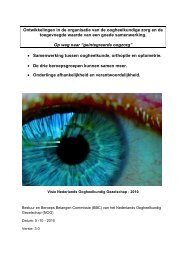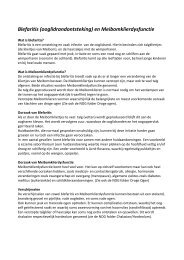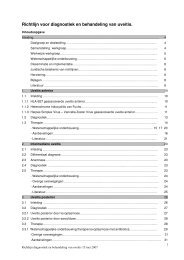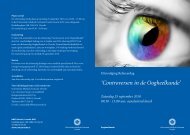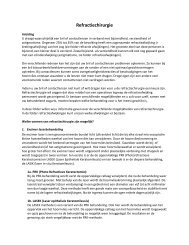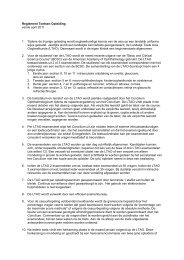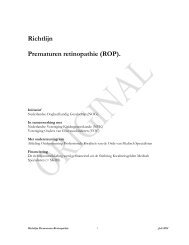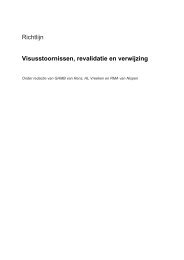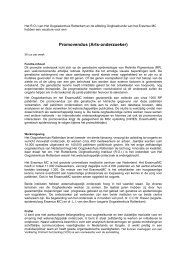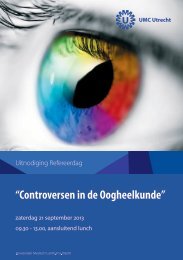terminology and guidelines for glaucoma ii - Kwaliteitskoepel
terminology and guidelines for glaucoma ii - Kwaliteitskoepel
terminology and guidelines for glaucoma ii - Kwaliteitskoepel
Create successful ePaper yourself
Turn your PDF publications into a flip-book with our unique Google optimized e-Paper software.
Argon Laser Iridotomy<br />
When no Nd:YAG laser is available, the Argon laser may be used.<br />
There is no single group of laser parameters <strong>for</strong> all types of iris <strong>and</strong> <strong>for</strong> all surgeons<br />
The laser parameters need to be adjusted intraoperatively<br />
Preparatory stretch burns:<br />
Penetration burns:<br />
Spot size: 200-500 µm Spot Size: 50 µm<br />
Exposure time: 0.2-0.6 seconds<br />
Exposure time: 0.2 seconds<br />
Power: 200-600 mW Power: 800-1000 mW<br />
For pale blue or hazel irides, the following parameters are suggested:<br />
First step: to obtain a gas bubble Spot Size 50µm<br />
Exposure time 0.5 seconds<br />
Power:<br />
1500 mW<br />
Second step: penetration through the gas bubble Spot Size 50µm<br />
Exposure time 0.05 seconds<br />
Power<br />
1000 mW<br />
For thick, dark brown irides:<br />
Chipping technique Spot Size 50 µm<br />
Exposure time 0.02 seconds<br />
Power<br />
1500-2500 mW<br />
The purpose of the procedure is to obtain a full thickness hole of sufficient diameter to resolve the pupillary block.<br />
Per<strong>for</strong>ation is assumed when pigment, mixed with aqueous, flows into the anterior chamber. The iris usually falls<br />
back <strong>and</strong> the peripheral anterior chamber deepens. Patency must be confirmed by direct visualization of the lens<br />
through the iridotomy. Transillumination through the pupil or the iridotomy is not a reliable indicator of success.<br />
The optimal size of the iridotomy is 100 to 500 µm.<br />
Complications:<br />
Temporary blurring of vision<br />
Corneal epithelial <strong>and</strong>/or endothelial burns with Argon<br />
Intraoperative bleeding, usually controlled by a gentle pressure applied to the eye with the contact lens<br />
Transient elevation of the IOP<br />
Postoperative inflammation<br />
Posterior synechiae<br />
Late closure of the iridotomy<br />
Localized lens opacities<br />
Endothelial damage<br />
Rare complications include retinal damage, cystoid macular edema, sterile hypopion, malignant <strong>glaucoma</strong>.<br />
Post-operative management:<br />
Check the IOP after 1-3 hours, <strong>and</strong> again after 24-48 hours. When this is not possible, give prophylactic treatment<br />
to avoid IOP spikes<br />
Topical corticosteroids <strong>for</strong> 4-7 days<br />
Repeat gonioscopy<br />
Pupillary dilatation to break posterior synechiae<br />
Verify the patency of the peripheral iridotomy<br />
Ch. 3 - 29 EGS



